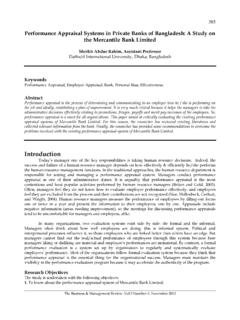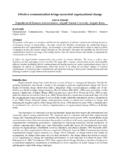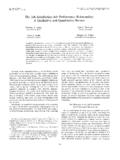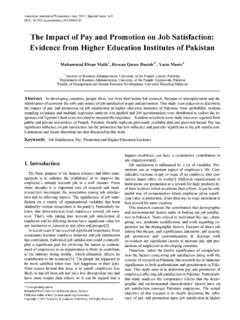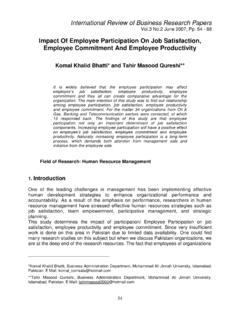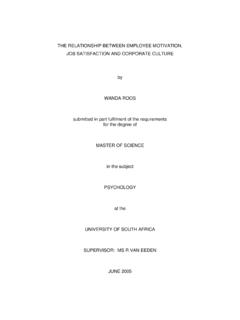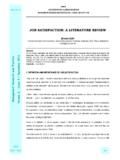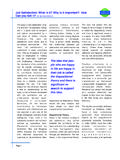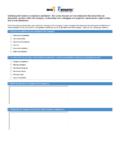Transcription of The Influence of Rewards and Job Satisfaction on …
1 The Influence of Rewards and Job Satisfaction on Employees in the Service Industry Shagufta Sarwar And James Abugre Swansea University, Wales, UK. Key words Rewards , employee Satisfaction , job Satisfaction , inducement, loyalty. Abstract The purpose of this study was to find out the relationship between employees' Rewards , and the dimension of their job Satisfaction in the service sector. We hypothesized that Rewards play a significant role in employee Satisfaction , resulting in increased customer Satisfaction and loyalty. Thus the role of job satisfcation and Rewards was explored with samples from workers in two large Ghanian private organizations. The implications of job satisfcation on customer Satisfaction and loyalty towards organzations were also invetsigated.
2 A questionnaire was constructed, tested and administered to a total 110 subjects at two private organizations. Out of that 104 usable surveys were analyzed with microsoft excel to test the hypotheses of the study. Findings showed that Rewards induced positive job Satisfaction of employees. Additionally the findings also showed that job Satisfaction of employees stimulated their loyalty to the organization. However, a very high level of employee dissatisfaction was recorded for employee pay and the amount work they do. The study result highlights the role of employees' job Satisfaction and the responsibilities of organizations in fostering good quality HRM practices in the service sectors, and offers an alternative pathway in employee Satisfaction and performance.
3 These results add to the evidence that HR practises influences business outcomes rather than the other way around. Introduction From both anecdotal and research-based accounts, worker's job Satisfaction is a major concern for management in many modern organizations (Westover & Taylor 2010; Westover et al 2010). Thus over the past years, studies on job Satisfaction have generated considerable interest among researchers globally. This has further led to a debate as to what variables actually impact employees' Satisfaction with their job, which in turn leads to improved productivity in work organizations. While many argue that each business entity whether small, medium or big has its own unique way of motivating its employees, job Satisfaction of workers can be commonly grouped into five distinct model categories: need fulfillment, discrepancies, value attainment, equity, and dispositional/genetic components models (Kinicki & Kreitner 2007).
4 These are explained as: need fulfillment is based on the Satisfaction determined by the extent to which a job, with its specified characteristics and duties, allows an individual worker to meet his/her personal needs. Second, the discrepancy model explains that Satisfaction is a result of met, or sometimes unmet, expectations. Third, the value attainment models are based on the belief that Satisfaction comes from the perception that one's job fulfills an individual's work values. Fourth, the equity models assert that Satisfaction is based on the perception of how fairly an individual is treated at work. This is largely based on how one's own work outcomes, relative to his/her inputs and efforts, compare to the input/output of others in the work place, and lastly; the dispositional/genetic components models suggest that individual employee differences are just as important for determining job Satisfaction and success as workplace related factors (Kinicki & Kreitner, 2007).
5 Job Satisfaction is one of the most important and significant variables in organizational behavior and in work organizations. It is the general attitude of an employee to the job. The higher the job Satisfaction , the more likely workers will hold a positive attitude toward their jobs (Wang & Feng 2003), and are more likely to be committed to the organization. Similarly, workers with higher level of job Satisfaction would display a decreased propensity to search for a job and decreased propensity to leave the organization (Wright & Bonett 2007). In the same way, employees who perceive their needs as unmet grow in general dissatisfaction and become increasingly attracted to competing places of employment (Tziner 2006), and often result in voluntary termination and organizational turnover (Mathieu & Zajac 1990).
6 As a result, job Satisfaction has been described as a complicated and multi-faceted construct (Lagace et al., 1993). This is because individuals differ in the way they perceive Satisfaction . Hence, Taber and Alliger (1995), for example, emphasized that to understand overall job attitudes, researchers must examine the principal tasks and activities in which employees engage. Nevertheless, the most accepted and common facets of job Satisfaction are the satisfactions with pay, promotion opportunities, coworkers, supervision, and the work itself (Smith et al 1969). These five job facets typically account for a substantial amount of the variance in overall job Satisfaction (Kinicki et al 2002). Thus, since turnover appears to be a major issue for many organizations, and indeed a problem of considerable importance because of the costs associated with hiring and training new personnel; Rewards , particularly intrinsic Rewards , such as interesting job and job autonomy, are found to be the major drivers of job Satisfaction for most countries (Westover & Taylor 2010).
7 Beyond the findings of these studies, there are still gaps with regard to knowledge of the specific effects of the Influence of Rewards on job Satisfaction in the workplace, and the ways in which supervisors or managers can effectively manage employee Satisfaction . This study addresses both of these issues by examining the outcomes of employee Satisfaction and Rewards on work behavior. Accordingly, the purpose of this study is to investigate whether the relationship between perceptions of job Satisfaction and increased customer Satisfaction and loyalty are influenced by higher Rewards and employee Satisfaction . The main contribution of our study is to extend the HR literature on employee job Satisfaction and ascertain new ideas from employees in the service sector on some of the contemporary variables that stimulate employee Satisfaction .
8 Extant literature suggest that correlates of job Satisfaction including passion, talent use by employer, value congruence, fair pay, education, age, and gender (Westover et ) are important in work organizations. This study goes beyond the underlying components of job Satisfaction to unearth new insights of job Satisfaction variables from employees in the service industry. Literature It has been widely argued in management, total quality management, operational sciences and service literatures that improving job Satisfaction and loyalty leads to higher productivity and profits (Silvestro 2002). In particular the human resource management and organizational behavior theories suggest that the appropriate use of people enhances organizational effectiveness (Arthur 1994; Heskett, et al 1997; Tsui, et al 1997).
9 The past decades has seen the emergence of several studies which endeavor to lend empirical support to these relationships. Although most of the studies provide evidence of links between service quality, customer Satisfaction , loyalty and financial performance (Rust, et al. 1995;. Zeithaml, et al. 1996), not many studies have looked at the predictors of job Satisfaction from a subjective perspective (Borzaga & Tortia 2006). This study aims to explore the predicting variance of loyalty and reward on job Satisfaction of employees working in private sector. Job Satisfaction has been a topic of wide interest to both academic and practitioners for past four decades. In fact it has been one of the most frequently studied variables in organizational behavior research and human resource theory and practices (Spector 1997).
10 The traditional model of job Satisfaction focuses on all the feelings that an individual has about his/her job. However what makes a job satisfying The Business & Management Review, Number-2, January 2013. 23. or dissatisfying is not limited to the nature of the job but it also depends upon the individual's, perceptions, attitudes and expectations towards the job itself (Hong Lu, et al. 2005). The work of Maslow (Maslow 1954) has played a crucial role in developing and shaping many concepts in organizational behavior including job Satisfaction . Based on Maslow's theory, some researchers have approached job Satisfaction from a need fulfillment perspective (Kuhlen 1963; Worf 1970). However during the last two decades, this approach has become less popular as more researchers are emphasizing on the cognitive process rather than the underlying needs.

